 Agapanthus praecox 'White' Two types of plants are recommended for a firescaped garden: ‘fire retardant’ and ‘fire resistant’. These, together with a planting method which is designed to slow down a fire, and most importantly to create a safe zone around your home, will go a long way in protecting your home and family. It’s really quite simple!
Agapanthus praecox 'White' Two types of plants are recommended for a firescaped garden: ‘fire retardant’ and ‘fire resistant’. These, together with a planting method which is designed to slow down a fire, and most importantly to create a safe zone around your home, will go a long way in protecting your home and family. It’s really quite simple!
If you don't have space for a large wind or firebreak of trees or hedging plants, a belt of suitable, evergreen, low-growing vegetation will offer protection from wildfires. A selection of small shrubs that are widely spaced, and surrounded by a mat-forming groundcover will also offer protection, and even if the shrubs do catch alight the fire shouldn't spread far. In the buffer zone it advisable to use small plants that will re-sprout after a fire, as these will help to prevent soil erosion.
Thankfully there are many indigenous and exotic plants that can be used to firescape your garden, and the plants you select will be determined by the region you live in - its climate, rainfall, and soil type. Visit your local garden centre before finalising your plant list to ensure that the plants selected are suitable for your growing region.
Although a lot of research has been done on the fire resistance of many garden plants, the science of firescaping is still in its infancy and a lot of studies still need to be done on this subject. There are thousands of fire resistant plant lists available online, some of which are compiled simply by observing which garden plants have survived fierce wildfires, and which seemed to fuel the fires.
The plant list below is by no means complete and was compiled from information available in South Africa, and worldwide, but especially those fire prone regions of Australia and California, as they grow many of the same garden plants as we do in South Africa.
The purpose of this document is to provide homeowners with guidance on ways to landscape their property with fire resistant plants to help reduce losses from wildfire damage. It contains suggestions and recommendations, and is intended to serve only as a guide. If you live in a high fire zone it is recommended that you do your own research and seek advice from garden centres and locals in your area before making your final decision.
It must be noted that any plant can burn when exposed to flames and heat, it is just that some are less likely to ignite, or may take longer to ignite. For this reason you cannot rely on plant selection alone to stop bush fires, but it makes sense to use plants that generally do not readily ignite. They may be damaged or even killed by fire, but their foliage and stems do not significantly contribute to a fire's intensity. In essence, they can create a living wall that reduces and blocks intense heat. If sufficiently watered and maintained, annuals and lawns also can be part of a fire-resistant landscape.
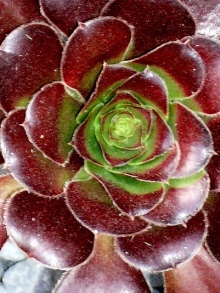
Tree Houseleek (Aeonium)
Combined with other succulents Aeonium are used to firescape gardens, and although they can be used in any of the garden zones, they are especially good for the buffer zone, as they are drought tolerant and their fleshy leaves will temper down a fire by catching the embers from advancing flames. Houseleeks vary in size from small specimens which grow almost flat against the ground to woody shrubs with stout basal stems reaching 1.5m, supporting multiple waxy rosettes. They come in shades of burgundy, green, and are sometimes splashed with pale gold.
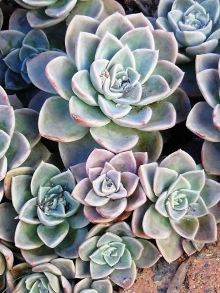
Rock Rose (Echeveria elegans)
Combined with other succulents Echeveria is used to firescape gardens, and although they can be used in any of the garden zones, they are especially good for the buffer zone, as they are drought tolerant and their fleshy leaves will temper down a fire by catching the embers from advancing flames. These short stemmed, clump-forming succulents form beautiful rosettes of silver-blue spoon-shaped leaves, often with pink to rose-red margins. The rock rose looks good all year round, is virtually maintenance free, and wonderfully adaptable.
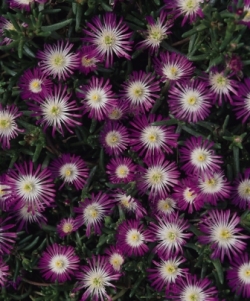
Ice Plant (Delosperma)
Combined with other succulents Delosperma is used to fire-scape gardens prone to wild fires, and although they can be used in any of the garden zones, they are especially good for the buffer zone, as they are drought tolerant and their fleshy leaves will temper down a fire by catching the embers from advancing flames. Planting a belt of Delosperma at least 50cm, but preferably 1m wide should stop or at least drastically slow down most grass fires. It forms a low mat of succulent leaves that spread quickly, making it an excellent groundcover for hot, dry slopes and sandy soils.

Hottentots Fig (Carpobrotus)
Combined with other succulents Carpobrotus is used to fire-scape gardens prone to wild fires, and although they can be used in any of the garden zones, they are especially good for the buffer zone, as they are drought tolerant and their fleshy leaves will temper down a fire by catching the embers from advancing flames. It is a vigorous succulent groundcover that is used as a pioneer plant on disturbed sites for the fast stabilization of sandy slopes. It makes a good fire-resistant barrier, and planting a belt of Carpobrotus, at least 50cm, but preferably 1m wide should stop or at least drastically slow down most grass fires.

Tapytmadeliefie (Dymondia margaretae)
Homeowners in fire prone regions are looking for attractive, drought resistant, low-maintenance groundcovers and lawn substitutes. Dymondia ticks all the boxes and is highly recommended for all the garden zones. This evergreen forms mats 2 to 7cm in height, and spreads 40 to 50cm, with growth so dense it chokes out almost all weeds. It is a great filler plant between pavers and invaluable to stabilise the soil on slopes.
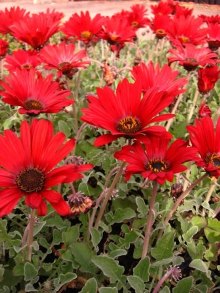
Renoster Arctotis (Arctotis acaulis)
Arctotis is recommended for firescaping the buffer zone, and is perfect for difficult seaside gardens. Every year more beautiful hybrids are available in a variety of forms, from clumping to spreading or trailing. In large areas they make a glorious groundcover, and will also quickly stabilise the soil on steep banks. Allow them to spill over low retaining walls or down the sides of steps, or plant them into pots and window boxes.

Heartleaf Bergenia (Bergenia cordifolia)
Bergenia is an evergreen, fast growing herbaceous perennial which has adapted to growing in many climatic conditions around the world. It is fire resistant because its large, glossy leaves do not burn easily, and it is usually used in the garden or low resistance part of a firescapd garden, which is generlly watered more regularly. Planted about 30cm apart, it makes a useful groundcover for semi-shaded areas of the garden.
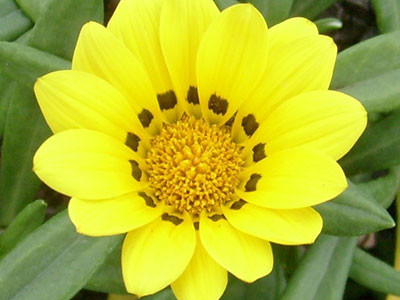
Gousblom (Gazania krebsiana)
The Commonwealth Scientific and Industrial Research Organisation (CSIRO) tested and listed the ignitability of Australian garden plants, and they listed Gazania hybrid on List 2, as exotic plants that are known to slow down a wild fire, and regularly appear on many lists as fire retardant plants. Gazania krebsiana is one of the parent plants of the many gorgeous gazania hybrids in garden centres today, and is also water-wise.
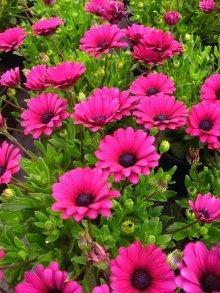
Trailing Daisy (Dimorphotheca)
These tough, water-wise daisies are listed for firescaping because their fibrous root system goes deep, enabling them to withstand veld fires, and re-sprout after a fire. They come in a wide selection of new cultivars and make lovely groundcovers. They are perfect candidates for stabilising sandy soils on embankments, and their trailing habit suits hanging baskets and pots.

Wild Daisy Bush, Harpuisbos (Euryops)
Euryops species are plentiful in southern Africa, producing their yellow blooms throughout the seasons. They are excellent pioneer species and one of the first plants to re-establish after a fire, making them good for the buffer zone to stabilise the soil after a fire has swept through. In winter rainfall regions they are water-wise. If you cut back dead plant material regularly they will not be a fire hazard.
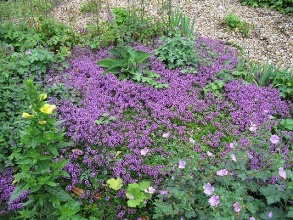
Creeping Thyme (Thymus)
There are very few ground covers that can be walked-on, but creeping thyme is one of them, emitting its fragrance when crushed. Despite the fact that the leaves contain oils, it appears on many firescaping plants lists. This little perennial evergreen is suitable as a lawn substitute in small areas, ideal between stepping stones or near to patios and walkways, and in pebble and rock gardens.

Lilyturf (Liriope muscari)
The Commonwealth Scientific and Industrial Research Organisation (CSIRO) tested and listed the ignitability of Australian plants. They listed Liriope muscari on List 2, as plants that regularly appear on lists as fire retardant plants. This low-growing, grass-like, evergreen is low-maintenance and a great groundcover or edging plant. Its useful to plant on steep slopes to prevent soil erosion.
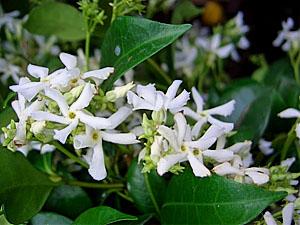
Star Jasmine (Trachelospermum)
The South Australian Country Fire Service lists star jasmine as fire retardant plant, and in the Knysna fires, perimeter walls covered in star jasmine were destroyed by the intense flames and heat. However, they protected the walls and homes within by being in the path of the fire and absorbing the impact of the blaze. This evergreen climber is also used as a groundcover for large areas, and sheared to maintain a height of about 40 to 60cm. It is also be grown as a shrub by regularly pinching off the tips, and as a standard plant.
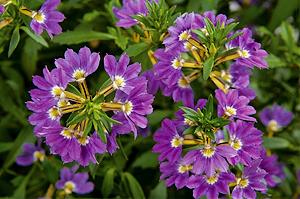
Fairy Fan-flower (Scaevola aemula)
The Commonwealth Scientific and Industrial Research Organisation (CSIRO) tested and listed the ignitability of Australian plants, and they listed Scaevola on List 2, as native plants that regularly appear on many lists as fire retardant plants. Scaevola is a prostrate and spreading little evergreen which makes a wonderful groundcover and edging plant for all types of gardens. It will also trail down beautifully if planted in hanging baskets and window boxes, and looks charming spilling over low walls or cascading down flights of stairs in the garden.
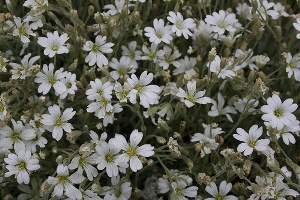
Snow-in-summer (Cerastium tomentosum)
This beautiful dense, evergreen appears on several fire-wise plant lists. It is a vigorous grower, reaching 15cm in height, and spreading by runners up to 1m. It looks good all year round and will add interest and contrast to the landscape. Plant it as a groundcover, border plant, or in rock and dry wall gardens. For a thick groundcover, plant it about 40cm apart.

Bugle Flower (Ajuga reptans)
In the United States, Ajuga is recommended as a groundcover in the garden, or medium resistance zone of a firescaped garden, as these low-level groundcovers provide little fuel for fires. This perennial is excellent for moist semi-shaded areas, and even tolerates dry shade. It spreads by runners and grows fairly quickly, but is generally not invasive.

Australian Violet (Viola hederacea)
This violet is listed as an excellent fast spreading perennial groundcover for all zones of a firescaped garden. It is perfect for shady areas where grass struggles to grow, and if watered well it also takes full sun, making it perfect underneath deciduous trees which allow the full sun through in winter but are shaded inderneath in summer. It is good to stabilise the soil on banks and lovely between pavers, and alongside pathways.
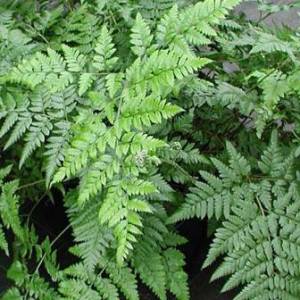
Leatherleaf Fern (Rumohra adiantiformis)
Because this fern spreads by underground rhizomes it is protected from fires, and even if killed by fire, will quickly regenerate after rain. Gardeners love these ferns for their hardiness and ease of growth, as well as their versatility in the garden. Their leathery, deep green leaves blend effortlessly into so many garden themes, and make an excellent permanent ground cover for those moist and semi-shady areas.
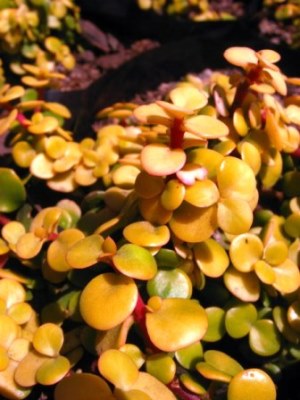
Dwarf Spekboom (Portulacaria afra)
The spekboom is highly recommended for all zones of the firescaped garden, and especially for the buffer zone as the spekboom is also very heat and drought tolerant, and a good soil binder. There are several forms. The dwarfs make excellent groundcovers, low growing shrubs or hedges. ‘Green Carpet’ is an excellent groundcover; 'Prostrata' grows 10 to 20cm tall; 'foliis variegata' sprawls on the soil, seldom growing over 20cm tall; 'Medio-picta' is also ground hugging; and ‘Tricolor’ has a lovely pendulous habit.

Soap Aloe, Bontaalwyn (Aloe maculata)
Aloe maculate, with its bright red to orange and yellow flowers on top of a multi-branched stalk up to 1m tall is an excellent fire-retardant succulent for areas prone to wild fires, because when not in bloom it is a small stemless aloe, only about 50cm tall, and spreads via suckers, making it a perfect groundcover for the buffer zone. It is extremely common in South Africa, with a wide distribution, and an excellent coastal plant that is salt tolerant. Because it will endure heat and long periods of drought, it is also a great addition to the xeriscaped or water-wise garden.
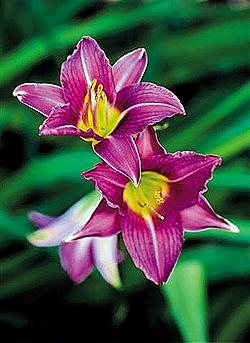
Daylily (Hemerocallis)
Daylilies are recommended for the garden or medium resistance zone. Species can be evergreen, semi-evergreen, or dormant. Dormant varieties die back in winter; evergreen varieties will remain evergreen, except in cold regions where they will go dormant with the first frost. Semi-evergreen varieties recede partially in winter, except in warm climates. This ensures that we have species to suit many climates.
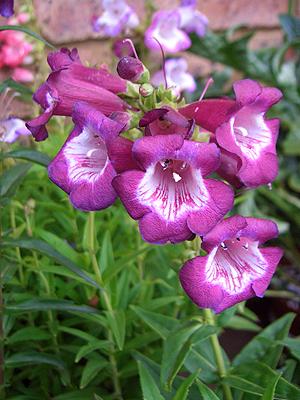
Beard-tongue (Penstemon)
Penstemon species appear consistently in firescaping plant lists for the garden or low resistant zones. The various cultivars come in many shapes and sizes, from dwarf varieties to larger plants, and are indispensable if you want colour in water-wise gardens. The smaller types are ideal in rockeries and the taller growing ones look spectacular planted at the back of the border, or next to boulders.

Wild Garlic, Isihaqa (Tulbaghia)
Tulbachia, with its succulent leaves, is recommended for firescaping in all the garden zones. It is a water-wise groundcover for large open areas on in complexes, office parks, parking lots and pavements. The two most popular species are Tulbaghia violacea and Tulbaghia simmleri, because they are proven low maintenance landscaping plants.
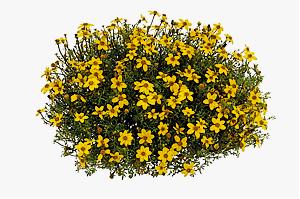
Bidens, Tickseed (Bidens ferulifolia)
Compact forms of bidens are recommended for the garden and low resistance zone of a firescaped garden as the drought resistant quality of these plants also helps them to endure hot, dry conditions, and if they are watered moderately will not burn easily. There is a wide variety of selections available, and many have a spreading or trailing form while others grow to be more mound shape.

Geranium (Pelargonium)
The popular Geraniums you find at most garden centres actually belong to the genus Pelargonium. These beautiful hybrid plants have been bred from our indigenous Pelargoniums and can flower all year round in ideal climatic conditions. They are fire resistant as their leaves don't burn easily, and are recommended for the garden or low resistance zone closest to the home, where they will only require moderate watering.

Carpet Geranium (Geranium incanum)
The carpet geranium appears in several firescaping lists as suitable for the buffer zone on the perimeter of the property for its ability to re-sprout after a fire and its ability to stabilise the soil. The carpet geranium grows abundantly and is often found growing together with fynbos on the slopes of hills, as well as on coastal dunes, and in damp coastal flats and seeps. It makes an excellent groundcover.
Members can click here to read more about the Carpet Geranium
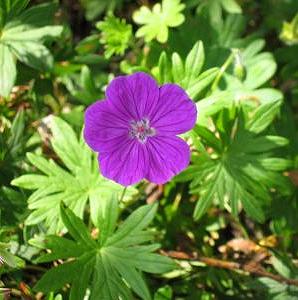
Bloody Crane's-bill (Geranium sanguineum)
This geranium appears in several firescaping lists as suitable for the buffer zone on the perimeter of the property for its ability to re-sprout after a fire. Its strong rootstock helps stabilise the soil on slopes, and its long-lived and does not require a lot of care, making it a good low maintenance groundcover. The plants spread slowly, and are suitable for perennial flower borders and in small rockeries.
Members can click here to read more about Bloody Crane’s Bill

Plantain Lily (Hosta)
Hosta can be planted in the garden or low resistance zone closest to your home where they can be watered regularly. They vary greatly in growth habit, with some reaching no more than 15cm tall and others growing up to 90cm tall. They are lovely in woodland gardens and shady pebble gardens, and are effective planted singly or in large groups, and because they are so easy to divide they make a wonderful groundcover under trees.

Bearded Irises (Iris)
The bearded iris can be used in all the garden zones of a firescaped landscape if they can be watered moderately during their growing season. They do not burn readily, and if a fire does sweep through, their thick rhizomes help protect the plants and they should re-sprout again. These rhizomes will hold the soil in place after a fire, and once established they are extremely water-wise and will only require watering when the top three inches of soil dries out. The watering frequency will depend to a great extent on your environment.
 hebeblueboy
hebeblueboy Veronica (Hebe)
Veronica does not burn readily and can be planted in the garden or low resistance zone close to the home. Hybridisation has resulted in many distinctive garden plants which will thrive in various climatic conditions. Veronicas are neat, compact, low maintenance and water-wise, and today they are available from tiny miniatures only 30cm high to varieties which will grow 1.5m tall. This diversity makes them available for gardeners in most Provinces of South Africa, and a 'must have' for gardens large or small.

Yarrow (Achillea millefolium)
Common yarrow is highly rated in numerous firescaping plant lists as having low ignitability, and is used as a fire barrier, created by replacing highly flammable vegetation with species that are less likely to burn and which can help prevent ignition or slow down the spread of the fire. Garden hybrids are tough and easy to grow, and since they can take heat, drought, and poor soil, they are a natural choice for difficult areas, and perfect to stabilise sandy soils and prevent soil erosion, especially on slopes.
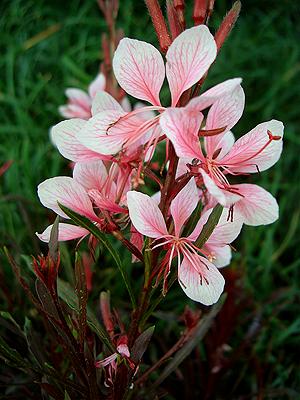
Butterfly Gaura (Gaura hybrids)
Gaura is recommended for firescaping because its long tap root enables it to survive drought, and to re-sprout quickly after a fire. Therefore, it is perfect for the buffer zone, and can also be utilised in the garden, or medium resistance zone. If planted in large drifts it makes a fantastic groundcover, and it’s wild, slightly unkempt look mixes well with grasses, aloes, and succulents in natural style plantings. Water well until established.
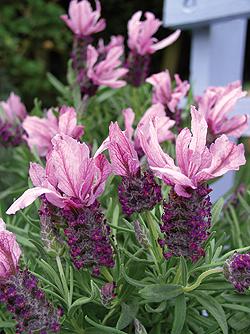
Lavender (Lavendula)
Lavender appears consistantly of fire resistant plant lists, as it offers a lot of benefits. In addition to being a slow-burning plant (as long as you keep it moist). It offers bursts of purple and green color to your landscape, plus it has a fresh fragrance. Although you should keep it moist for better fire resistance, lavender has low water needs and is a low-maintenance landscaping option. Growers continue to produce enticing new garden hybrids in all shades of purple, violet, lavender, blue, and white.
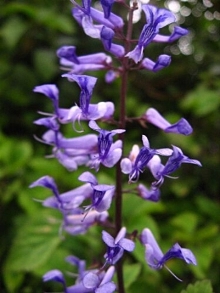
Spurflowers (Plectranthus)
Plectranthus species are recommended for the garden or medium resistance part of a firescaped garden, and also for the low resistance zone closest to the home. They are one of only a few plants that are ideally suited to grow under the shade of trees. The species vary in their growth forms, from prostrate ground covers to medium and large growing shrubs. If planted in large drifts Plectranthus looks beautiful in large beds, and the large growing varieties are often used as informal screens and hedges.
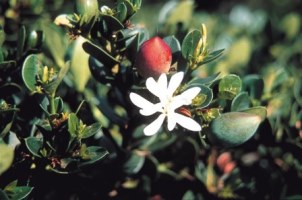
Dwarf Natal Plum, (Carissa macrocarpa)
This little num-num is a delightful dwarf variety with leathery, fire resistant leaves. It makes an excellent groundcover, growing approximately 30 to 40cm tall and 60cm wide. Like the large num-num, it is recommended to plant in regions prone to wildfires, and the sharp thorns it produces are neatly forked, making it a first class impenetrable little hedge. To grow a low hedge, plant out about 50cm apart. It’s also wonderful for the mixed shrub border and grows effortlessly in pots.
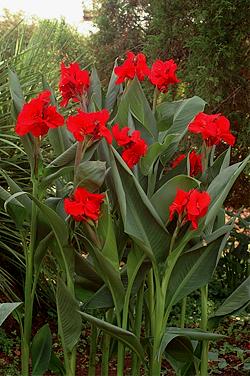
Canna Lily (Canna)
Cannas can be grown throughout South Africa, and they appear on firescaping lists from Australia and the USA. Their underground stems or rhizomes, which store starch, also protect the plant from wild fires. The thick seed coating allows canna seed to survive for a very long time, and in the wild, seeds germinate best in places burned by fire. As long as they are kept clean of dead material cannas can be used in the buffer zone, and also in the garden, or medium resistance zone.
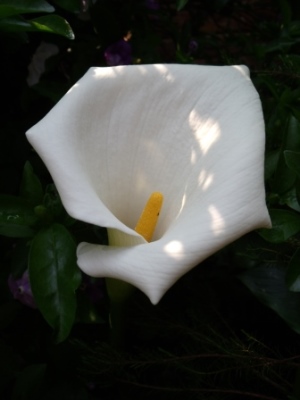
Arum Lily, mohalalitoe (Zantedeschia)
Arum lilies are used in the garden or medium resistance garden, and can be planted closer to the home, but try to keep them well watered during the growing season. There are many species but they are all wonderful lump-forming perennials which are grown for their lush foliage and ornate blooms. Most species are deciduous but some may remain evergreen; surviving the dry season by storing water in their fleshy rhizomes, and this also enables them to survive wildfires. In the wild plants occur in areas with seasonal rainfall; growing in the grassland, savanna and fynbos biomes in full sun, less often in semi-shade.
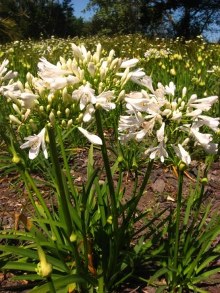
Agapanthus, Leta-laphofu (Agapanthus)
When it comes to fire breaks, Agapanthus remains one of the most popular plants, as their foliage slows down a fire, and their underground roots and tubers survive fires and help prevent the soil from being blown or washed away when there is little other vegetation around after a fire. And as soon as the rains return they will re-sprout. In Australia, farmers have used Agapanthus as fire breaks for over one hundred years, and they have proved their resilience, sparing many farms and homes from wildfires. Agapanthus can be used in all the garden zones, but is highly recommended for the buffer zone.

Red Hot Poker, Vuurpyle (Kniphofia)
Kniphofia has many species, and a few are deciduous but most are evergreen. The herbaceous species go dormant in winter and have narrow, grass-like leaves, varying in length from 10cm to 1m long, while the evergreen species have broader, strap-shaped foliage up to 1.5m long. Because the plants derive their nourishment from rhizomes growing well below ground, they are protected from wildfires, and able to re-sprout after fire. The large clumps they form prevent soil erosion. Pokers are exceptionally pretty planted between grasses and aloes.

Cut-leaf Philodendron (Philodendron)
Philodendrons are recommended for planting roughly 3m away from the house, in the garden or medium resistance part of a firescaped garden. Today an exciting new group of Philodendron sports known as "self-headers" are available, like: Philodendron ‘Compacta’; 'Xanadu'; and 'Hope'. These do not scramble like the tree philodendron, but have a wonderful compact growth habit. They make handsome, low maintenance specimen plants for the garden, and an ideal groundcover for a dramatic impact in large landscape areas like office parks, schools, colleges etc.
